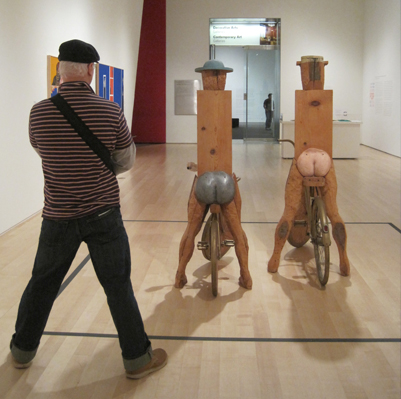Subversive women of Pop Art.
 Thursday, March 3, 2011 at 2:30PM
Thursday, March 3, 2011 at 2:30PM  by Jeanne Chinard
by Jeanne Chinard
As a young woman coming of age in the late sixties, I was lucky enough to live in Greenwich Village and have cheap, or free, access to every gallery and museum in New York. It was the height of the Vietnam War and women’s lib was just beginning to explode, fueled in large part by the readily available and revolutionary birth control pill.
But even as the pill was starting to give women more sexual freedom, the Playboy Club was the most popular men’s destination in Manhattan. And in universities, in business, in the art world and in society, women were still viewed through a warped lens. You could achieve anything – up to a point. Being educated and informed was fine, as long as you didn’t go public with it. You might even be successful – unless you had children. As a result, all of the art we were hungry to see every Sunday afternoon was created by men.
We’ve come along way, right? From the significant presence of women in the 2010 Whitney Biennial or the many global solo shows of rising artists, the art world has slowly begun to recognize and applaud women artists. Which is why my reaction to the Brooklyn Museum exhibit, “Seductive Subversion: Women Pop Artists 1958-1968,” came as such a surprise to me. Because even though I consider myself supremely liberated, as I went through the exhibit I started to feel surprisingly empowered.
Why would I feel that way if we’ve come such a long way? I was dismayed to realize that an entire show of women artists is still the exception in 2010. But I was stunned to learn how talented these artists were and yet are barely known today. They didn’t just experiment with Pop Art, but they explored and helped create Abstract Expressionism and Photorealism as well. They influenced the culture, and undoubtedly the many iconic male artists they knew well, such as Claes Oldenburg, Roy Lichtenstein, and Willem de Kooning, among others. These women were substantial, serious artists.
And yet… in the magazines and newspaper articles that accompanied each artist’s work, it was easy to see the most celebrated were also the most attractive. In fact, several of the artists were known as much, or more, for their looks and edgy glamour as they were for their art. Marisol, Pauline Boty, Niki de Saint Phalle, were beautiful women with “you can’t ignore me” personalities. Today, their social lives would be avidly chronicled on Twitter and in the blogosphere. Indeed, the beautiful and tragic Pauline Boty was compared to Brigitte Bardot, yet she was central to the British Pop Art movement. In fact, she was the only female artist in a four “man” show with Blake, Derek Boshier and Peter Phillips, which was later hailed as Britain’s first Pop Art show.
A young woman today might ask why these artists we shouldn’t be celebrated as much for their sex appeal as for their art. Her generation doesn’t see any reason to separate glamour and power, so it’s hard for them to understand just how different attitudes towards women were not so very long ago. I suppose this is a good thing, and hopefully has happened because of what we went through when we were their age. But what my generation experience is exactly what makes the output of this earlier generation of women Pop artists even more significant to me.
As women, these artists were more exposed and had more to lose; yet many of them took more risks than their male counterparts. They had the imagination and the technical skill. And they experimented with materials, but also with message. It wasn’t just their art that was daring. They were also making political statements about women’s issues and women’s power, or lack of it, which the culture at large wasn’t ready to embrace. Their work may not have sold, but they forced the viewer to reconsider the degrading way women were treated in advertising and the media.
These artists were bold and in-your-face and supremely gifted. And yet, the two “positive” reviews of the show I read in The New York Times and Time Out were still somewhat dismissive of the work itself. They seem to qualify it, it was “good, but” - implying that if these women had been “really great artists,” their work would be better known today. I strongly disagree. I believe that if gallerists, established male artists and art critics had taken them seriously, they would be much better known and more highly considered today.
The fact truth is that in the late fifties and early sixties, most art critics refused to include female artists in art books and few gallery owners would show their work.
If they did, it was often as the token woman or as a novelty. Idelle Weber, whose remarkable plexiglass cubes containing silhouettes of 1950’s businessmen could easily have been the inspiration for the opening credits of Madmen, was refused permission to audit a class by Robert Motherwell. The reason? He told her that because she was a married woman who wanted children she could never become a serious artist. Rosalyn Drexler exhibited with Andy Warhol and Roy Lichtenstein and yet is not widely known today. Nor is the sculptor Marisol who had a successful first exhibition at The Leo Castelli Gallery. Nor Evelyne Axell, who studied privately with René Magritte.
So if it was their intelligence and talent that drove them to create, it was their sex, their beauty and their moment in time that left them in the artistic dust.
These “subversive” artists didn’t fail to become household names because their art wasn’t good enough. They failed to become household names because the global art machine is still dominated by men. If not, then why is this the first major New York exhibition of female Pop artists? Why are shows of women artists still a novelty? More important, why is the sex of an artist even an issue in the 21st century?
If you ever have a chance to see any of these artist, please do. Take your daughters and your granddaughters. Better yet, take your sons and your grandsons.





